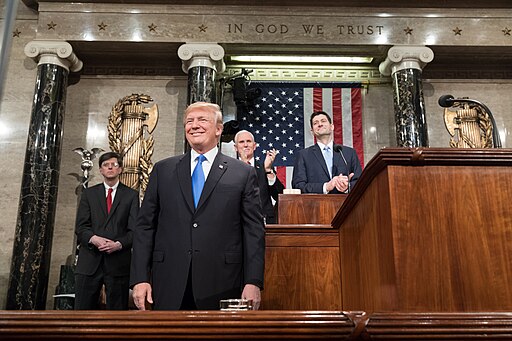Well, Trump blinked. In his standoff with House Speaker Nancy Pelosi (D-CA) over the 2019 State of the Union address, the president finally conceded that he doesn’t get to deliver the speech before a joint session of Congress unless he’s invited to do so — technically by the House and Senate, but as a practical matter by Pelosi herself. She’s going to wait until the ongoing “government shutdown” ends to invite him. He’s going to impatiently await that day.
It’s not very often that I agree with any politician, let alone Pelosi. When I do, it’s usually on “even a stopped clock is right twice a day” grounds. This matter included. I don’t really care WHY she withdrew the invitation. I just hope it stays withdrawn. Forever.
The Constitution requires the president to “from time to time give to the Congress Information of the State of the Union, and recommend to their Consideration such Measures as he shall judge necessary and expedient.”
It does not require the president to do so in the form of a live speech. While the first two presidents (George Washington and John Adams) gave State of the Union speeches, the third (Thomas Jefferson) just sent a written report — as did every subsequent president for more than a century, until Woodrow Wilson revived the speech ritual.
Radio, then television, transformed the State of the Union address from mere constitutional busy work into something else entirely: A free campaign commercial for the sitting president and a shorter one for the opposition party.
The sitting president gets as long as he cares to take — Bill Clinton is the record-holder at 89 minutes — to harangue his cabinet, the Supreme Court, and both houses of Congress, in front of the American people, on all the major broadcast TV networks and cable news channels). The opposition party gets to respond in kind, usually at much shorter length, with a likely future presidential contender sometimes chosen as that party’s face.
Now, I am not a fan of campaign finance law. In my opinion, anyone who wants to donate his or her money to a political candidate should be allowed to do so in any amount.
But that body of law does exist, and the value of, say, two hours of prime time television on all the biggest channels (not counting the “newsy” countdown stories and post-speech “analysis”) far exceeds maximum legal campaign contribution limits. If all of the declared candidates for the next presidential election were given “equal time,” that might make it legal. But it would also be boooorrrrring.
It’s 2019. The president of the United States doesn’t have to schlep down to Capitol Hill to deliver a speech. He can fulfill his constitutional duty with a written report. Or, heck, with a constantly updated web site that automagically updates statistics revealing the “state of the union.” If he wants to speechify, he can embed a YouTube video or set up a Google Hangout.
End the “State of the Union” dog and pony show. Permanently.
Thomas L. Knapp (Twitter: @thomaslknapp) is director and senior news analyst at the William Lloyd Garrison Center for Libertarian Advocacy Journalism (thegarrisoncenter.org). He lives and works in north central Florida.
PUBLICATION/CITATION HISTORY
- “A Campaign Finance Proposal: Let’s Do Away with SOTU,” by Thomas L. Knapp, River Cities’ Herald (Iowa), 01/24/19
- “Get rid of the State of the Union address. Be like Jefferson — he sent Congress a written report.” by Thomas L. Knapp, Miami, Florida Herald [web and print], 01/24/19
- “Let’s do away with the SOTU,” by Thomas L. Knapp, Hendricks County, Indiana Flyer, 01/25/19
- “A Campaign Finance Proposal: Let’s Do Away with SOTU,” by Thomas L. Knapp, OpEdNews, 01/25/19
- “A campaign finance proposal: Let’s do away with SOTU,” by Thomas L. Knapp, Montgomery, West Virginia Herald, 01/25/19
- “It’s Time to Abolish the State of the Union Address,” by Jared Keller, Pacific Standard magazine, 02/05/19
- “A Campaign Finance Proposal: Let’s Do Away with SOTU,” by Thomas L. Knapp, CounterPunch, 01/28/19
- “Let’s do away with SOTU,” by Thomas L. Knapp, Shreveport, Louisiana Inquisitor (paywalled cache link), 02/01/19
- “A Campaign Finance Proposal: Let’s Do Away with SOTU,” by Thomas L. Knapp, Ventura County, California Citizens Journal, 02/01/19



